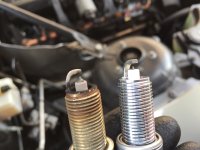Hi folks, there's probably a load of articles on how to do this, but though I'd share my experiences...
I have a 2007 N52 2.5i Z4 - it was having a few hiccups on acceleration at sub 2k revs. The job came in under £150.
1) Replaced all 6x coils with Bosch 0-221-504-470 - these are the revised version of what was in the car before (Bosch 0-221-504-467) according to Bosch's website. At the time of writing these are only about £17 each on Amazon - grab a bargain folks!
2) Replaced all 6x spark plugs with NGK iridium ILZFR6D11 - from CarParts4Less with one of their discounts, came in at just over £9 each.

Tools you'll need:
6mm hex head for removing the plastic engine cover (might be 4 or 8, but if you've got a set you'll be fine)
M10 spark plug socket and ratchet
Torque wrench
A tea towel/rag, and some olive oil or such (I'll come to that bit
Something to gap the plugs with (pliers and hammer) and a feeler gauge. Google how to do this, and if you wreck your plugs don't blame me ;-)
1) Whip off the plastic engine cover. You don't need to remove the cross brace
2) Unclip each plug that goes into each coil. Pull the plug out of the coil and get it clear of the coil.
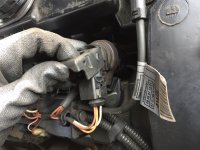
3) Now for the tea towel or rag - hook it through the plastic clip and pull. Give the coil a roundabout wiggle if you fancy. They're quite hard to pull out but will come eventually with a champagne cork like pop. Repeat for all coils.
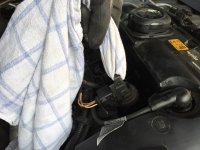
4) Check there's no rubbish lying around in the bottom of the holes and undo the spark plugs, one at a time. Mine were quite tough but nothing too bad. Install each new plug after whipping out the old one, finger tight at this stage. You don't want to leave holes open into the cylinders for longer than you have to.
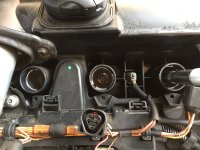
5) Once all the new plugs are in, torque them up to 23 Nm +/- 3 Nm (in the BMW service manual).
6) Push the new coils into place - I started at cylinder 6 (near the bulkhead). They'll push into place with a small 'bump'. I found cylinder 4 to be the most tricky - it's next to the motor that looks after the variable valve timing (I think). Put a smidge of olive oil on the side of the motor to help the rubber coil slide past it if you're having trouble ;-)
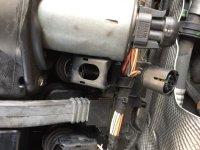
Put the plugs back in - push them as far as they'll go and then put the clip down (watch your fingers, they can bite!). Repeat for all coils. Get the plugs all the way in or you'll get a misfire (I did, ha!). Don't leave any 'gap' at the 'top'/towards passenger side, of the 'oval shape' hole in the top of the clip.
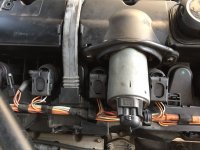
7) Clear your tools up and fire it up - should be running happily! If you have an OBDII reader or Carly, perform a reset so the computer can re-learn the new coils and spark plugs.
8 ) Put the plastic engine cover back on and have a cuppa before taking it out for a spin!
I have a 2007 N52 2.5i Z4 - it was having a few hiccups on acceleration at sub 2k revs. The job came in under £150.
1) Replaced all 6x coils with Bosch 0-221-504-470 - these are the revised version of what was in the car before (Bosch 0-221-504-467) according to Bosch's website. At the time of writing these are only about £17 each on Amazon - grab a bargain folks!
2) Replaced all 6x spark plugs with NGK iridium ILZFR6D11 - from CarParts4Less with one of their discounts, came in at just over £9 each.

Tools you'll need:
6mm hex head for removing the plastic engine cover (might be 4 or 8, but if you've got a set you'll be fine)
M10 spark plug socket and ratchet
Torque wrench
A tea towel/rag, and some olive oil or such (I'll come to that bit
Something to gap the plugs with (pliers and hammer) and a feeler gauge. Google how to do this, and if you wreck your plugs don't blame me ;-)
1) Whip off the plastic engine cover. You don't need to remove the cross brace
2) Unclip each plug that goes into each coil. Pull the plug out of the coil and get it clear of the coil.

3) Now for the tea towel or rag - hook it through the plastic clip and pull. Give the coil a roundabout wiggle if you fancy. They're quite hard to pull out but will come eventually with a champagne cork like pop. Repeat for all coils.

4) Check there's no rubbish lying around in the bottom of the holes and undo the spark plugs, one at a time. Mine were quite tough but nothing too bad. Install each new plug after whipping out the old one, finger tight at this stage. You don't want to leave holes open into the cylinders for longer than you have to.

5) Once all the new plugs are in, torque them up to 23 Nm +/- 3 Nm (in the BMW service manual).
6) Push the new coils into place - I started at cylinder 6 (near the bulkhead). They'll push into place with a small 'bump'. I found cylinder 4 to be the most tricky - it's next to the motor that looks after the variable valve timing (I think). Put a smidge of olive oil on the side of the motor to help the rubber coil slide past it if you're having trouble ;-)

Put the plugs back in - push them as far as they'll go and then put the clip down (watch your fingers, they can bite!). Repeat for all coils. Get the plugs all the way in or you'll get a misfire (I did, ha!). Don't leave any 'gap' at the 'top'/towards passenger side, of the 'oval shape' hole in the top of the clip.

7) Clear your tools up and fire it up - should be running happily! If you have an OBDII reader or Carly, perform a reset so the computer can re-learn the new coils and spark plugs.
8 ) Put the plastic engine cover back on and have a cuppa before taking it out for a spin!
